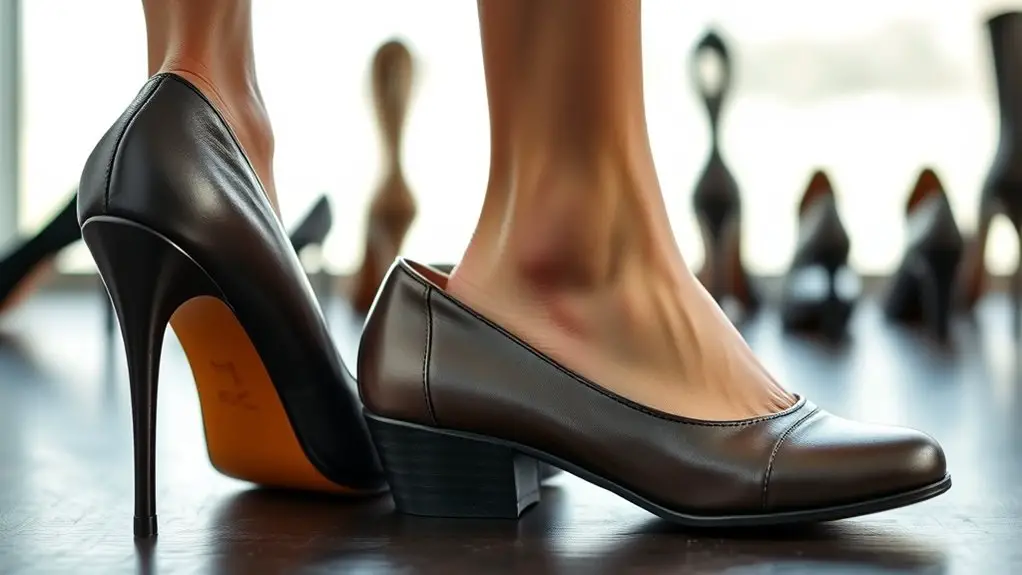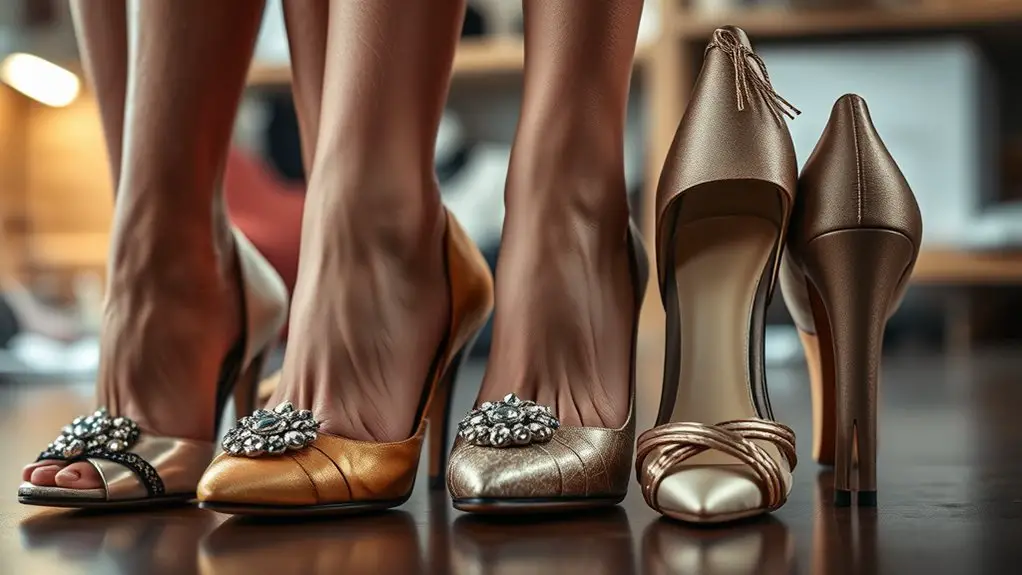Heel height greatly impacts shoe design, affecting comfort, stability, and aesthetics. Higher heels demand a precise balance and robust materials for support, while lower heels can leverage lightweight fabrics for comfort. The shift in center of gravity influences body mechanics, necessitating innovative structural designs like arch support to ease strain. With fashion trends often prioritizing style, understanding the trade-off with foot health becomes essential. There’s a lot more to uncover about how heel height shapes footwear choices.
The Impact of Heel Height on Comfort

When you slip on a pair of heels, you might not immediately reflect on how the height affects your comfort level. The right heel height can transform your experience, blending style with essential comfort features. Designers are increasingly focusing on ergonomic design, ensuring that each step you take feels more natural and less strenuous.
Higher heels often create a striking silhouette, but they can also lead to discomfort if not designed thoughtfully. Features like cushioned insoles, arch support, and shock-absorbent materials play an essential role in maintaining comfort during prolonged wear.
You’ll want to evaluate the angle of your foot and how it interacts with the shoe’s structure. A well-constructed heel balances aesthetic appeal with functionality, allowing you to strut confidently without sacrificing comfort. Ultimately, the right heel height, combined with innovative design, can elevate both your look and your overall well-being.
Biomechanics of Walking and Standing
As you navigate through your day, the biomechanics of walking and standing play an essential role in how your body interacts with the ground beneath you. Your gait analysis reveals the intricate dance of muscles, joints, and tendons working in harmony, allowing you to move fluidly. With each step, balance mechanics kick in, adjusting your posture and stabilizing your core to prevent falls.
Heel height dramatically influences this delicate balance. While a higher heel can create an elegant silhouette, it shifts your center of gravity, forcing your body to compensate for stability. Conversely, lower heels promote a more natural gait, enhancing comfort and reducing strain. Understanding these dynamics not only informs your shoe choices but also highlights the importance of footwear design in supporting ideal biomechanics. In a world where style meets science, being mindful of how heel height affects your movement can elevate both your look and your well-being.
Material Choices Based on Heel Height

When you consider heel height, the choice of materials becomes vital for stability and support. Lightweight yet flexible fabrics can enhance comfort without sacrificing style, while sturdier options are essential for higher heels to maintain balance. It’s all about finding the perfect blend that supports your stride while keeping you ahead of the fashion curve.
Stability and Support Factors
While many people choose shoes based on style, the stability and support factors tied to heel height often go unnoticed. When you’re selecting a pair, consider how heel height impacts the shoe’s stability features and support mechanisms. For lower heels, materials like rubber and foam provide excellent grip and cushioning, ensuring comfort without sacrificing support. Conversely, higher heels require more robust materials, like structured leather or reinforced plastics, which enhance stability. Designers integrate features like arch supports and heel counters to maintain balance. This means that your footwear not only elevates your style but also adapts to your movement, ensuring that every step feels secure. Prioritizing these factors can help you stride confidently in any heel height.
Weight and Flexibility Considerations
Choosing the right materials for your shoes is essential, especially since weight and flexibility directly affect comfort and performance. The heel height you choose impacts how weight distribution occurs throughout the shoe, influencing your overall experience. Here are some material considerations to keep in mind:
- Lightweight foams: Ideal for lower heels, offering great flexibility range while minimizing fatigue.
- Stiffer materials: Perfect for higher heels, providing necessary support without compromising too much on flexibility.
- Breathable fabrics: Enhance comfort, allowing for natural movement regardless of heel height.
Selecting the right balance between these materials guarantees you get the support and ease you need, whether you’re strutting in stilettos or gliding in flats.
Structural Design Variations for Different Heels
Although heel height can dramatically influence a shoe’s aesthetic appeal, the structural design variations that accompany different heel styles are equally important for comfort and stability. When you explore various heel shapes, you’ll notice that each demands unique design elements and support structures. For instance, a stiletto requires precise construction techniques to guarantee balance, while block heels often incorporate wider bases for enhanced stability features.
Material innovations also play a significant role; lightweight foams and flexible leathers can improve comfort without sacrificing style. Furthermore, functional designs like arch support and cushioning systems are essential, especially in higher heels, to prevent discomfort during prolonged wear. Your aesthetic choices in color and texture should harmonize with these structural components, creating a shoe that’s not only visually striking but also dependable. By understanding these variations, you can make informed decisions that elevate both your style and comfort.
Target Audience Preferences and Heel Height

When it comes to heel height, preferences can vary considerably across different demographics, with many fashion-forward individuals gravitating toward styles that blend trendiness with comfort. Your target audience’s design preferences often hinge on their lifestyle and personal style, shaping their choices in fascinating ways.
Consider these key factors:
Key factors influencing heel height preferences include profession, occasion, and the essential need for comfort in daily wear.
- Profession: Those in corporate settings might prefer moderate heels for a polished look, while creatives may opt for bolder heights.
- Occasion: Events dictate heel selections; think elegant pumps for weddings versus stylish flats for casual outings.
- Comfort Level: Many prioritize comfort, especially if they’re on their feet all day, leading to a rising demand for lower or block heels.
Fashion Trends and Their Influence on Heel Selection
As fashion trends evolve, they subtly shape your heel selection, guiding you toward styles that resonate with the latest aesthetics. With each season, iconic silhouettes emerge from runway designs, reflecting cultural influences and consumer behavior. Celebrity endorsements amplify these trends, making certain heel heights and styles highly sought after.
You’ll notice how seasonal trends dictate color palettes, leading you to opt for bold hues or muted tones, depending on the market demand. The style evolution also embraces fashion sustainability, encouraging you to contemplate eco-friendly materials in your choices.
As you curate your wardrobe, remember that your heel selection isn’t just about personal preference; it’s a reflection of the dynamic fashion landscape. Balancing aesthetics with practicality keeps your collection fresh and relevant, allowing you to express yourself while staying attuned to the ever-changing world of fashion.
Health Implications of Different Heel Heights
When it comes to heel heights, your choice can greatly impact your foot health and overall posture. Wearing higher heels might give you that chic edge, but it can throw off your balance and lead to long-term discomfort. Let’s explore how different heel heights might affect your well-being and what that means for your daily style.
Foot Health Concerns
Although high heels may elevate your style, they often come with a price—your foot health. The wrong heel height can lead to discomfort and long-term issues. You might find yourself experiencing:
- Foot fatigue: Prolonged wear can exhaust your feet, making them ache after just a few hours.
- Lack of arch support: Many heels lack the essential support your arches need, increasing the risk of pain and injury.
- Joint strain: High heels can misalign your body’s natural mechanics, causing strain on your knees and hips.
To keep your feet happy, consider choosing styles that incorporate better arch support and moderate heel heights. Balancing fashion with function is key—your feet will thank you in the long run!
Posture and Balance Effects
The impact of heel height on your posture and balance can’t be overlooked. When you slip into a pair of high heels, you may experience a shift in your center of gravity, which can lead to a cascade of effects on your spine and overall alignment. While some may argue that stilettos can enhance your silhouette, they often hinder posture correction and can lead to long-term imbalances. Lower heel heights, on the other hand, promote balance improvement, allowing you to walk more naturally and comfortably. If you’re keen on maintaining good posture and ideal body mechanics, consider opting for styles that support your alignment while keeping you stylish. After all, your feet deserve just as much attention as the latest trends.
Frequently Asked Questions
How Does Heel Height Affect Shoe Lifespan and Durability?
Ever wonder why some shoes last longer? Heel height considerably impacts lifespan; higher heels often wear unevenly, altering wear patterns. Choosing the right heel materials can enhance durability, ensuring your favorite pair withstands the test of time.
What Are the Best Heel Heights for Different Occasions?
For casual events, low to medium heel heights offer comfort and style, while formal occasions often call for higher heels, enhancing elegance. Balance is key—choose what complements your outfit and guarantees you feel confident.
Do Certain Heel Heights Influence Foot Odor?
When it comes to foot odor, you’ve hit the nail on the head. Certain heel heights can trap heat, increasing sweat retention. Prioritizing foot hygiene is key to keeping odors at bay, regardless of your shoe choice.
How Can Heel Height Impact Arch Support?
Heel height variations can greatly affect arch support mechanisms in shoes. When you choose higher heels, your foot’s natural arch can be compromised, leading to discomfort. Finding the right balance is essential for both style and support.
Are There Specific Heel Heights Recommended for Different Foot Shapes?
When it comes to heel height recommendations, different foot shapes often require tailored options. A flatter foot might benefit from lower heels, while higher arches could enjoy moderate heights, ensuring ideal foot shape compatibility and comfort.



